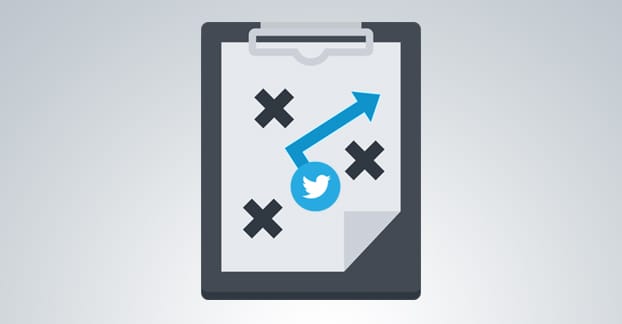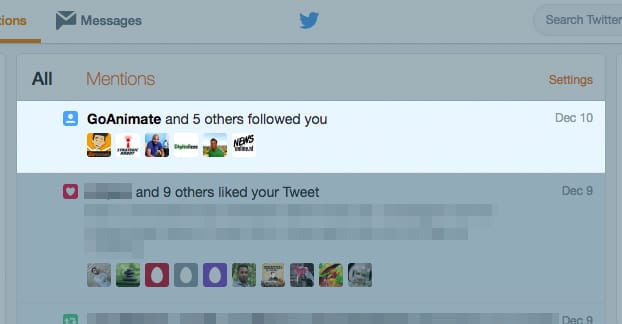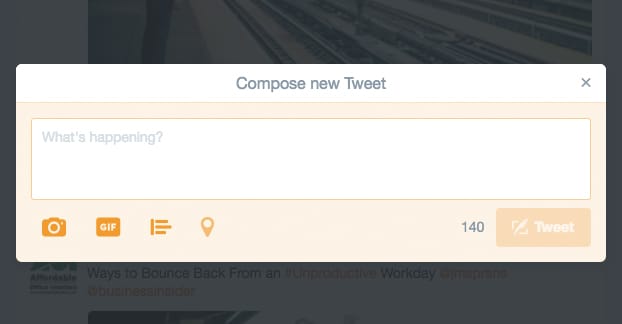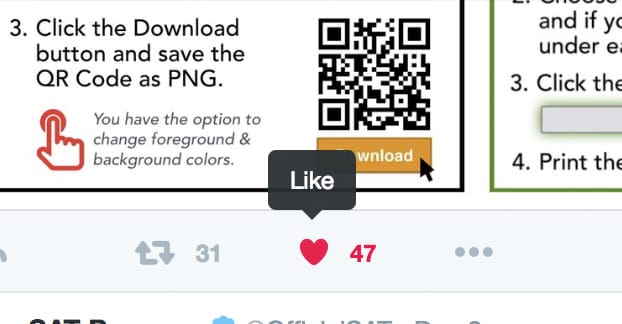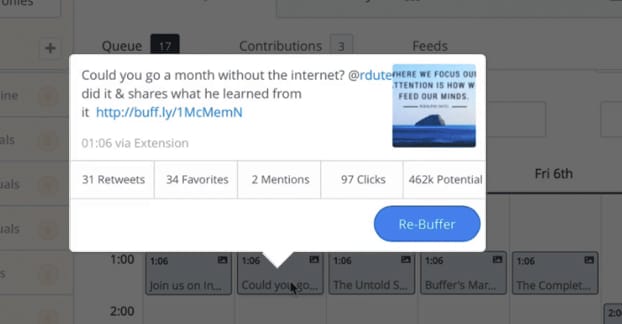The ideal strategy for content on Twitter will be a little flexible, because different audiences value different things. Different brands have different types of content to provide. Therefore, I’ll be speaking in relatively general terms. Your goals will be roughly the same regardless of who you are, though, and the types of content you have to work with will be the same as well. It’s all about how you put the pieces together.
Goals with Twitter
Regardless of who you are, whether you’re a brand, a personal account, or somewhere in the middle, you can always boil down your goals to one of three. Every possible goal is just a nuance of one of these. If you don’t think your goal is aiming at one or another of them, you’re not thinking deep enough.
Goal number one is to gain more followers. Everyone has this goal on Twitter, except maybe Katy Perry, who is the number one most followed account on the entire site. I’m sure her social managers are perfectly content to hold that title, but at the same time, a lot of other accounts are growing to try to take it, so she needs to keep ahead of them with her own growth.
Everything you do has the goal of earning you more followers. Some posts will have one of the other two goals as the primary goal, but every tweet is made with the hope that someone who hasn’t followed you before sees the tweet, decides it’s good enough to follow you for, and clicks that little blue button.
Goal number two is to network with influencers. Influencers are people within your industry who have significant numbers of engaged followers. If one of them tweets your content, you’re bound to get a significant boost in traffic, engagement, and even follows from it. That’s why they’re so valuable, and that’s why they’re in a position you want to be in. Growing more Twitter followers is a way to become an influencer, and networking with existing influencers is a way to grow more followers of your own. Tweeting the right kind of content to the right people at the right time in the right way can capture the attention of an influencer, and help boost you into the exclusive upper circles of your industry.
Goal number three is to funnel people to your website. We all want to make money, right? Well, we aren’t doing it on Twitter. We’re doing it on our websites, selling our products and services, running our ads, promoting our affiliate offers. The whole purpose of a Twitter account is to grow your brand reputation, your name, and awareness of your site. All of that just drills down to the desire for profits, to greed. It’s not a bad thing, it’s how our world works, but it’s the underlying foundation beneath everything we do on social media, at least as marketers.
Types of Content
I’ve been able to boil content down into a few categories, plus one modifier category. Different types of content serve different purposes within a grand marketing plan. Let’s go over them.
The first type of content is simple posts. They have no images, no links, nothing but the 140 characters of text and hashtags you want to use. They are simple announcements, information, jokes, and interactions. They’re in some ways the most human, least branded content you can post, because without even a link or an image, you’re saying “I’m sacrificing visibility in favor of having something to say.” That’s not always the case, but it’s a fact that no-media tweets tend to be the least engaged and least visible content on social media.
The second type of content is on-Twitter media. Primarily this means static images, perhaps with text over them, that are designed to draw in attention and expand upon a message. This also includes animated gifs, Vines, longer videos, and even Periscope livestreams if you’re into that kind of thing. It’s content that draws more attention and engagement, but keeps it all on Twitter.
The third type of content is links to your own website blog posts. These are generally known as “soft sell” posts, in that they are designed to funnel people to your site, but not in a way that’s made for sales. It’s a way to show people that your site has value, in a way that provides some of that value up front, without trying to get them to do anything beyond read and acknowledge that you exist. One common Twitter trap is that brands do nothing but post this kind of content, which means a lot of users don’t really like it. However, it’s all about perspective. What’s the difference between you posting your link and an influencer posting it? Context.
The fourth type of content is the hard-sell link to a landing page. These are the clear calls to action, where you’re not just trying to get people to your site, you’re trying to get them to your site with the intent to purchase something, opt in to something, or sign up for something. This is the most beneficial for marketing, in a direct profits kind of way, but it’s also the hardest to use. Too much of it will kill your feed and your followers as surely as any poison.
The fifth type of content is links to content you didn’t produce but want to share. The dirty secret is that this is just the third type of content, from a different perspective. It’s content you think your users would be interested in seeing, but that you didn’t create. It makes users feel good to be following you, because you’re providing interest and value without asking for anything in return, not even clicks to your own site. In reality, of course, you’re asking for their attention and loyalty to you.
The sixth type of content is retweets from influencers, comprised of the other five types of content. This is the modifier content. Influencers might not be sharing anything different from what you’re sharing, but because their names have clout, more value is attached to those posts. It’s curated content with extra value on the side, like pizza with extra cheese.
A Sample Strategy
So, you know what the general goals are, and you know the types of content you have to work with. So how do you put the pieces together in a way that makes sense and accomplishes those goals? Here’s a process for you. It’s a skeleton of a process, more a list of steps you can fill in for yourself.
The first step is to determine your goals, major and minor, for your Twitter presence. I’m not talking about the Big Three up there, though they’re all important. I’m talking about dividing them down and drilling into them to find discrete, measurable goals. Set them down somewhere you can remember them, and more importantly, somewhere you can set your data up against so you know how well you’re achieving them.
Some ideas for goals are: generating leads for your site, building brand awareness, boosting your positive sentiment, providing customer support, becoming a thought leader, and building a community. These are by no means all of the possible goals; they’re just options for you to consider while you think of your own.
Some of these goals will be harder than others to achieve. If one is particularly hard, you might have to look at your goal and decide if it’s right for Twitter, or if you should be using another platform to achieve it.
The second step is to figure out who your audience is and what kinds of content they like the most. To do this, you need to make use of a bunch of different Twitter tools out there. Figure out demographics. Figure out associations with other brands. Figure out where they stand in relation to your brand already.
I’m glossing this over, because there are a million ways to harvest this data, and anyway it’s all part of what you should do as a marketer in general. If you don’t know your audience, what are you doing?
The third step is to figure out some details, like what you’re using to schedule posts and when the best times to schedule them are. Again, using tools to determine this information will be very useful. I can tell you what the ideal time is to tweet for myself, but that information might not apply to you and your following. Every audience is unique.
Now, just because there’s a “best time” to tweet doesn’t mean you need to schedule 8 posts for that short time slot. No, you want to space your content out throughout the day. You should just use the timing to determine when your most important posts will be made.
The fourth step is to determine how many posts per day or week you can handle making consistently. Remember, here, the number one thing to keep in mind: consistency is key. Sure, you can probably come up with 40 tweets you want to make right now. Post them all today, and you’re going to struggle tomorrow. People don’t necessarily mind if you’re tweeting 10-15 times per day, so long as you’re spacing them out and keeping it consistent. It’s only when you’re doing that once a week or once a month, with little or no posting the rest of the time, that you run into issues with spam.
I like to start at around 3-5 tweets per day. Studies have shown something like 3 being the ideal number, but again, it varies from audience to audience. 3 per day gives you 21 posts per week to work with, which isn’t too bad.
The fifth step is to figure out how many of each type of content can go in your marketing plan. If we’re going with three posts per day, you have 21 posts per week. One of them, max, should be your hard sell. Too many hard sells and you’re going to have a rough time actually selling. That leaves 20.
Of those 20, I like maybe 4 of them to be my own posted links. This is partially due to how I post; I write two blog posts per week. Allocating 4 tweets allows me to post each one twice, once when published and once as an encore. It works out pretty well, and leaves us with 16 remaining slots.
Media and plain text posts will vary and I rather consider them to be one category; they’re “my” content versus the links and influencer retweets, which are “their” content. Of the 16 remaining, I would say 5 of them can be flexible with “my” content. It’s enough to allow me to act and react without flooding people with excess personal advertising.
The remaining 11 posts will be curated content of various forms, largely filler. Most people don’t pay a ton of attention to this, but they’ll notice if you don’t have it, so it’s good to bulk up on this final category. I err on the side of influencer retweets more than link shares, but feel free to experiment with your own balance.
The sixth step is to start implementing your plan and monitor how it goes. Adjust your balance, adjust your sources of curated content, experiment with sharing more or less of your own content. Figure out what balance works best to accomplish your goals.
The seventh step is to iterate changes to your plan, more of some content and less of others, to improve your goals. You won’t start out perfect. No one starts out perfect. What you need to do is learn how to adapt and adjust your techniques until you’ve struck the perfect balance. Then you need to recognize that no balance is perfect, and that growth is a constant string of iterations, stretching into the end of time. Your work is never done.
